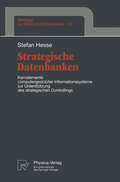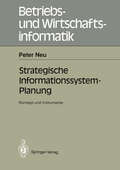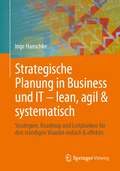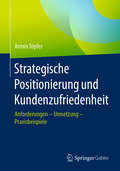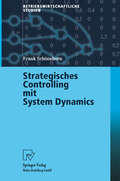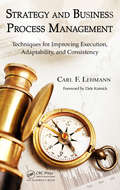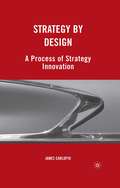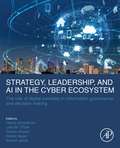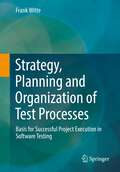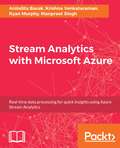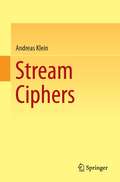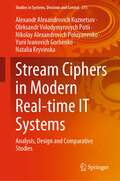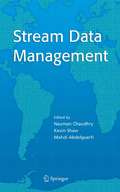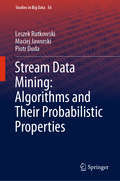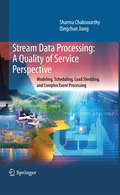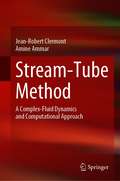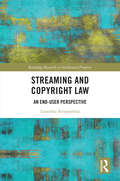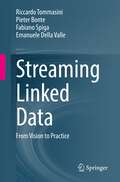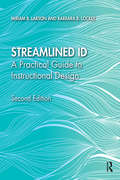- Table View
- List View
Strategische Datenbanken: Kernelemente computergestützter Infomationssysteme zur Unterstützung des strategischen Controllings (Beiträge zur Wirtschaftsinformatik #16)
by Stefan HesseStrategische Datenbanken werden als Kernelemente computergestützter Informationssysteme zur Unterstützung des strategischen Controllings konkretisiert. Die inhaltliche Bestimmung erfolgt anhand einer Betrachtung des strategischen Informationsbedarfs. Die technologischen Anforderungen gehen vom Konzept der Executive Information Systeme aus. Vor diesem Hintergrund werden neuere Datenbanktechnologien (z.B. objektorientierte) hinsichtlich ihrer Eignungspotentiale untersucht. Als wichtige Informationsquellen werden auch externe Online-Datenbanken analysiert. Schließlich wird ein strategisches Datenmodell entworfen und ein erweiterbares Datenbanksystem zur Implementierung einer strategischen Datenbank vorgeschlagen.
Strategische Informations-system-Planung: Konzept und Instrumente (Betriebs- und Wirtschaftsinformatik #48)
by Peter NeuIm Rahmen der strategischen Informationssystem-Planung sind die grundlegenden Entscheidungen über die Architektur des Informationssystems zu treffen. Für diese Problemstellung werden Ziele, Aufgaben und unterstützende Verfahren beschrieben. Drei Aspekte sind dabei wesentlich für das in der vorliegenden Arbeit beschriebene Konzept: - Ausrichtung an den UnternehmenszielenDie Gestaltung des Informationssystems muß konsequent an den ökonomischen Zielen des Unternehmens orientiert sein. Dies bedeutet, daß die Analyse dieser Ziele und ihrer Auswirkungen auf das Informationssystem zentraler Bestandteil der Planung ist. - GanzheitlichkeitDie strategische Informationssystem-Planung mit ihren Elementen Analyse der Ausgangssituation, Definition der strategischen Ziele und Festlegung der Architektur wird in Form von Teilaufgaben beschrieben, die den gesamten Planungsprozeß abdecken. - Praktische UmsetzungFür jede Teilaufgabe wird beschrieben, welche Verfahren zu ihrer Durchführung eingesetzt werden können. Damit wird die praktische Umsetzbarkeit des entwickelten Konzepts besonders betont.
Strategische Planung in Business und IT – lean, agil & systematisch: Strategien, Roadmap und Leitplanken für den ständigen Wandel einfach & effektiv
by Inge HanschkeMit diesem Buch erhalten Sie kompaktes Wissen zur Ausrichtung der IT an den Geschäftserfordernissen:- Geschäftstreiber verstehen und nachvollziehbar dokumentieren- Systematisch Anforderungen an die IT ableitenMit dem Ziel-Bild vor Augen und der Roadmap für die Umsetzung gestalten Sie die digitale Transformation – vom Business bis zur technischen Umsetzung. Schaffen Sie so die organisatorischen Voraussetzungen für die strategische IT-Planung. Dashboards und KPIs zur wirksamen Steuerung der Umsetzung der Planung sind dabei wichtige Hilfsmittel. Ein Schritt-für-Schritt-Leitfaden und ein ausführliches Glossar unter-stützen Sie bei Ihrer Arbeit.
Strategische Positionierung und Kundenzufriedenheit: Anforderungen – Umsetzung – Praxisbeispiele
by Armin TöpferAufgrund der aktuellen Entwicklung der Märkte wird Kundenorientierung zu einem immer wichtigeren Thema für Unternehmen. Kundenzufriedenheit kann dabei nur erreicht werden, wenn die strategische Positionierung des Unternehmens die Erwartungen und Anforderungen der Abnehmer in vollem Maße trifft. Vor diesem Hintergrund behandelt das Buch die Grundlagen der Entstehung sowie Messung und Bewertung von Kundenzufriedenheit. Ursachen-Wirkungs-Beziehungen werden herausgearbeitet und wesentliche Kernpunkte für eine erfolgreiche kundenorientierte Unternehmensstrategie definiert. Neue Verfahren zur Echtzeitmessung ermöglichen dabei eine rasche und gezielte Detailsteuerung. Für die Praxis besonders wertvoll sind die vorgestellten Lösungsansätze für häufige Umsetzungsprobleme sowie ausführliche Erläuterungen zu den Instrumenten der Kundenbindung in den verschiedenen Phasen einer Kundenbeziehung.
Strategizing Continuous Delivery in the Cloud: Implement continuous delivery using modern cloud-native technology
by Garima Bajpai Thomas SchuetzDiscover various cloud services alongside modern software development practices and tools with the guidance of two industry leaders in DevOps Purchase of the print or Kindle book includes a free PDF eBookKey FeaturesModernize continuous delivery in the cloud with strategic goals and objectivesMaster continuous delivery with the right tools, applications, and use casesPerform multi-cluster and multi-cloud deployments efficientlyBook DescriptionMany organizations are embracing cloud technology to remain competitive, but implementing and adopting development processes while modernizing a cloud-based ecosystem can be challenging. Strategizing Continuous Delivery in Cloud helps you modernize continuous delivery and achieve infrastructure-application convergence in the cloud. You’ll learn the differences between cloud-based and traditional delivery approaches and develop a tailored strategy. You’ll discover how to secure your cloud delivery environment, ensure software security, run different test types, and test in the pre-production and production stages. You’ll also get to grips with the prerequisites for onboarding cloud-based continuous delivery for organizational and technical aspects. Then, you’ll explore key aspects of readiness to overcome core challenges in your cloud journey, including GitOps, progressive delivery controllers, feature flagging, differences between cloud-based and traditional tools, and implementing cloud chaos engineering. By the end of this book, you’ll be well-equipped to select the right cloud environment and technologies for CD and be able to explore techniques for implementing CD in the cloud.What you will learnUncover the foundation for modernizing continuous delivery and prepare for continuous delivery in cloudBuild fast, efficient, secure, and interoperable software for real-world resultsUnderstand end-to-end continuous delivery for multi-cloud, hybrid, and on-premiseSet up and scale continuous delivery in the cloud for maximum returnImplement cost optimization for continuous delivery in the cloudDiscover trends and advancements in CD with cloud-native technologiesWho this book is forThis book is for developers, site reliability engineers, DevOps architects, and engineers looking to strategize, plan, and implement continuous delivery in the cloud. You must have a basic understanding of CI/CD concepts and be familiar with cloud ecosystem, DevOps, or CI/CD pipelines.
Strategy and Business Process Management: Techniques for Improving Execution, Adaptability, and Consistency
by Carl F. LehmannThis book prepares readers to master an IT and managerial discipline quickly gaining momentum in organizations of all sizes - Business Process Management (BPM). It describes how BPM treats processes as a portfolio of strategic assets that create and deliver customer and shareholder value and adapt, when necessary, enabling competitive advantage thr
Strategy and Business Process Management: Techniques for Improving Execution, Adaptability, and Consistency
by Carl F. LehmannThis book prepares readers to master an IT and managerial discipline quickly gaining momentum in organizations of all sizes - Business Process Management (BPM). It describes how BPM treats processes as a portfolio of strategic assets that create and deliver customer and shareholder value and adapt, when necessary, enabling competitive advantage thr
Strategy by Design: A Process of Strategy Innovation
by J. CarlopioStrategy by Design illustrates how to use many of the principles, processes and tools of the design profession to create innovative break-through organizational strategies.
Strategy in the Age of Disruption: A Handbook to Anticipate Change and Make Smart Decisions
by Henrik Von Scheel Ciprian Popa Joshua Von ScheelSeize your place in a new era in commerce and industry In Strategy in The Age of Disruption, a team of dedicated strategists delivers an exciting and practical guide to Industry 4.0, a commercial transformation that’s impacting every facet of the market, the environment, and our social lives. You’ll learn what Industry 4.0 is, what it means for you and your company, and how you—as a leader, manager, expert, entrepreneur, or investor—can capitalize on it and put it into practice. This is a complete handbook on strategic execution. It’s a step-by-step tutorial designed to get you to clearly see your strategic position, the choices available to you, and how to execute on those choices. You’ll also find: Ways to move beyond outdated business models that no longer serve the companies that follow them Common myths about strategy and how to put them to bed for good Deep and insightful explanations of the fourth industrial revolution and what it means for your sector and companyHighly visual and endlessly engaging, Strategy in The Age of Disruption will systematically guide you through how to manage the challenges of the present and the promise of the future.
Strategy in the Age of Disruption: A Handbook to Anticipate Change and Make Smart Decisions
by Henrik Von Scheel Ciprian Popa Joshua Von ScheelSeize your place in a new era in commerce and industry In Strategy in The Age of Disruption, a team of dedicated strategists delivers an exciting and practical guide to Industry 4.0, a commercial transformation that’s impacting every facet of the market, the environment, and our social lives. You’ll learn what Industry 4.0 is, what it means for you and your company, and how you—as a leader, manager, expert, entrepreneur, or investor—can capitalize on it and put it into practice. This is a complete handbook on strategic execution. It’s a step-by-step tutorial designed to get you to clearly see your strategic position, the choices available to you, and how to execute on those choices. You’ll also find: Ways to move beyond outdated business models that no longer serve the companies that follow them Common myths about strategy and how to put them to bed for good Deep and insightful explanations of the fourth industrial revolution and what it means for your sector and companyHighly visual and endlessly engaging, Strategy in The Age of Disruption will systematically guide you through how to manage the challenges of the present and the promise of the future.
Strategy, Leadership, and AI in the Cyber Ecosystem: The Role of Digital Societies in Information Governance and Decision Making
by Hamid Jahankhani Arshad Jamal Liam M. O’Dell Gordon Bowen Daniel HaganStrategy, Leadership and AI in the Cyber Ecosystem investigates the restructuring of the way cybersecurity and business leaders engage with the emerging digital revolution towards the development of strategic management, with the aid of AI, and in the context of growing cyber-physical interactions (human/machine co-working relationships). The book explores all aspects of strategic leadership within a digital context. It investigates the interactions from both the firm/organization strategy perspective, including cross-functional actors/stakeholders who are operating within the organization and the various characteristics of operating in a cyber-secure ecosystem. As consumption and reliance by business on the use of vast amounts of data in operations increase, demand for more data governance to minimize the issues of bias, trust, privacy and security may be necessary. The role of management is changing dramatically, with the challenges of Industry 4.0 and the digital revolution. With this intelligence explosion, the influence of artificial intelligence technology and the key themes of machine learning, big data, and digital twin are evolving and creating the need for cyber-physical management professionals. Discusses the foundations of digital societies in information governance and decision-makingExplores the role of digital business strategies to deal with big data management, governance and digital footprintsConsiders advances and challenges in ethical management with data privacy and transparencyInvestigates the cyber-physical project management professional [Digital Twin] and the role of Holographic technology in corporate decision-making
Strategy, Planning and Organization of Test Processes: Basis for Successful Project Execution in Software Testing
by Frank WitteThe book provides concrete tips for the successful organization of software tests. Because: Planning and conception in advance are essential for successful test projects. Setting the right course prevents problems from the outset and highlights the need for action in software testing. In addition to theoretical basics, this work shows the implementation in practice and deals with typical problems. Frank Witte explains the decisive aspects to be considered in the test concept in order to optimally support and accompany the test process.This book is a translation of the original German 1st edition Strategie, Planung und Organisation von Testprozessen by Frank Witte, Springer Fachmedien Wiesbaden GmbH, part of Springer Nature in 2020. The translation was done with the help of artificial intelligence (machine translation by the service DeepL.com). A subsequent human revision was done primarily in terms of content, so that the book will read stylistically differently from a conventional translation. Springer Nature works continuously to further the development of tools for the production of books and on the related technologies to support the authors.
Stream Analytics with Microsoft Azure
by Anindita Basak Krishna VenkataramanMicrosoft Azure is a very popular cloud computing service used by many organizations. Its latest analytics offering – Stream Analytics, allows you to process and get actionable insights from different kinds of data in real-time. This book is your guide to understand the basics of how Azure Stream Analytics works, and build your own analytics solution using its capabilities.
Stream Ciphers
by Andreas KleinIn cryptography, ciphers is the technical term for encryption and decryption algorithms. They are an important sub-family that features high speed and easy implementation and are an essential part of wireless internet and mobile phones. Unlike block ciphers, stream ciphers work on single bits or single words and need to maintain an internal state to change the cipher at each step. Typically stream ciphers can reach higher speeds than block ciphers but they can be more vulnerable to attack. Here, mathematics comes into play. Number theory, algebra and statistics are the key to a better understanding of stream ciphers and essential for an informed decision on their safety. Since the theory is less developed, stream ciphers are often skipped in books on cryptography. This book fills this gap. It covers the mathematics of stream ciphers and its history, and also discusses many modern examples and their robustness against attacks. Part I covers linear feedback shift registers, non-linear combinations of LFSRs, algebraic attacks and irregular clocked shift registers. Part II studies some special ciphers including the security of mobile phones, RC4 and related ciphers, the eStream project and the blum-blum-shub generator and related ciphers. Stream Ciphers requires basic knowledge of algebra and linear algebra, combinatorics and probability theory and programming. Appendices in Part III help the reader with the more complicated subjects and provides the mathematical background needed. It covers, for example, complexity, number theory, finite fields, statistics, combinatorics. Stream Ciphers concludes with exercises and solutions and is directed towards advanced undergraduate and graduate students in mathematics and computer science.
Stream Ciphers in Modern Real-time IT Systems: Analysis, Design and Comparative Studies (Studies in Systems, Decision and Control #375)
by Alexandr Alexandrovich Kuznetsov Oleksandr Volodymyrovych Potii Nikolay Alexandrovich Poluyanenko Yurii Ivanovich Gorbenko Natalia KryvinskaThis book provides the most complete description, analysis, and comparative studies of modern standardized and most common stream symmetric encryption algorithms, as well as stream modes of symmetric block ciphers. Stream ciphers provide an encryption in almost real-time regardless of the volume and stream bit depth of converted data, which makes them the most popular in modern real-time IT systems. In particular, we analyze the criteria and performance indicators of algorithms, as well as the principles and methods of designing stream ciphers. Nonlinear-feedback shift registers, which are one of the main elements of stream ciphers, have been studied in detail. The book is especially useful for scientists, developers, and experts in the field of cryptology and electronic trust services, as well as for the training of graduate students, masters, and bachelors in the field of information security.
Stream Data Management (Advances in Database Systems #30)
by Kevin Shaw Mahdi Abdelguerfi Nauman ChaudhryResearchers in data management have recently recognized the importance of a new class of data-intensive applications that requires managing data streams, i.e., data composed of continuous, real-time sequence of items. Streaming applications pose new and interesting challenges for data management systems. Such application domains require queries to be evaluated continuously as opposed to the one time evaluation of a query for traditional applications. Streaming data sets grow continuously and queries must be evaluated on such unbounded data sets. These, as well as other challenges, require a major rethink of almost all aspects of traditional database management systems to support streaming applications. Stream Data Management comprises eight invited chapters by researchers active in stream data management. The collected chapters provide exposition of algorithms, languages, as well as systems proposed and implemented for managing streaming data. Stream Data Management is designed to appeal to researchers or practitioners already involved in stream data management, as well as to those starting out in this area. This book is also suitable for graduate students in computer science interested in learning about stream data management.
Stream Data Mining: Algorithms and Their Probabilistic Properties (Studies in Big Data #56)
by Leszek Rutkowski Maciej Jaworski Piotr DudaThis book presents a unique approach to stream data mining. Unlike the vast majority of previous approaches, which are largely based on heuristics, it highlights methods and algorithms that are mathematically justified. First, it describes how to adapt static decision trees to accommodate data streams; in this regard, new splitting criteria are developed to guarantee that they are asymptotically equivalent to the classical batch tree. Moreover, new decision trees are designed, leading to the original concept of hybrid trees. In turn, nonparametric techniques based on Parzen kernels and orthogonal series are employed to address concept drift in the problem of non-stationary regressions and classification in a time-varying environment. Lastly, an extremely challenging problem that involves designing ensembles and automatically choosing their sizes is described and solved. Given its scope, the book is intended for a professional audience of researchers and practitioners who deal with stream data, e.g. in telecommunication, banking, and sensor networks.
Stream Data Processing: Modeling, Scheduling, Load Shedding, and Complex Event Processing (Advances in Database Systems #36)
by Sharma Chakravarthy Qingchun JiangThe systems used to process data streams and provide for the needs of stream-based applications are Data Stream Management Systems (DSMSs). This book presents a new paradigm to meet the needs of these applications, including a detailed discussion of the techniques proposed. Ii includes important aspects of a QoS-driven DSMS (Data Stream Management System) and introduces applications where a DSMS can be used and discusses needs beyond the stream processing model. It also discusses in detail the design and implementation of MavStream. This volume is primarily intended as a reference book for researchers and advanced-level students in computer science. It is also appropriate for practitioners in industry who are interested in developing applications.
Stream-Tube Method: A Complex-Fluid Dynamics and Computational Approach
by Jean-Robert Clermont Amine AmmarThis book presents the stream-tube method (STM), a method offering computational means of dealing with the two- and three-dimensional properties of numerous incompressible materials in static and dynamic conditions. The authors show that the kinematics and stresses associated with the flow and deformation in such materials can be treated by breaking the system down into simple computational sub-domains in which streamlines are straight and parallel and using one or two mapping functions in steady-state and non-steady-state conditions.The STM is considered for various problems in non-Newtonian fluid mechanics with different geometries. The book makes use of examples and applications to illustrate the use of the STM. It explores the possibilities of computation on simple mapped rectangular domains and three-dimensional parallel-piped domains under different conditions. Complex materials with memory are considered simply without particle tracking problems.Readers, including researchers, engineers and graduate students, with a foundational knowledge of calculus, linear algebra, differential equations and fluid mechanics will benefit most greatly from this book.
Streaming and Copyright Law: An end-user perspective (Routledge Research in Intellectual Property)
by Lasantha AriyarathnaThis book examines the challenges posed to Australian copyright law by streaming, from the end-user perspective. It compares the Australian position with the European Union and United States to draw lessons from them, regarding how they have dealt with streaming and copyright. By critically examining the technological functionality of streaming and the failure of copyright enforcement against the masses, it argues for strengthening end-user rights. The rising popularity of streaming has resulted in a revolutionary change to how digital content, such as sound recordings, cinematographic films, and radio and television broadcasts, is used on the internet. Superseding the conventional method of downloading, using streaming to access digital content has challenged copyright law, because it is not clear whether end-user acts of streaming constitute copyright infringement. These prevailing grey areas between copyright and streaming often make end-users feel doubtful about accessing digital content through streaming. It is uncertain whether exercising the right of reproduction is appropriately suited for streaming, given the ambiguities of "embodiment" and scope of "substantial part". Conversely, the fair dealing defence in Australia cannot be used aptly to defend end-users’ acts of streaming digital content, because end-users who use streaming to access digital content can rarely rely on the defence of fair dealing for the purposes of criticism or review, news reporting, parody or satire, or research or study. When considering a temporary copy exception, end-users are at risk of being held liable for infringement when using streaming to access a website that contains infringing digital content, even if they lack any knowledge about the content’s infringing nature. Moreover, the grey areas in circumventing geo-blocking have made end-users hesitant to access websites through streaming because it not clear whether technological protection measures apply to geo-blocking. End-users have a severe lack of knowledge about whether they can use circumvention methods, such as virtual private networks, to access streaming websites without being held liable for copyright infringement. Despite the intricacies between copyright and access to digital content, the recently implemented website-blocking laws have emboldened copyright owners while suppressing end-users’ access to digital content. This is because the principles of proportionality and public interest have been given less attention when determining website-blocking injunctions.
Streaming and Copyright Law: An end-user perspective (Routledge Research in Intellectual Property)
by Lasantha AriyarathnaThis book examines the challenges posed to Australian copyright law by streaming, from the end-user perspective. It compares the Australian position with the European Union and United States to draw lessons from them, regarding how they have dealt with streaming and copyright. By critically examining the technological functionality of streaming and the failure of copyright enforcement against the masses, it argues for strengthening end-user rights. The rising popularity of streaming has resulted in a revolutionary change to how digital content, such as sound recordings, cinematographic films, and radio and television broadcasts, is used on the internet. Superseding the conventional method of downloading, using streaming to access digital content has challenged copyright law, because it is not clear whether end-user acts of streaming constitute copyright infringement. These prevailing grey areas between copyright and streaming often make end-users feel doubtful about accessing digital content through streaming. It is uncertain whether exercising the right of reproduction is appropriately suited for streaming, given the ambiguities of "embodiment" and scope of "substantial part". Conversely, the fair dealing defence in Australia cannot be used aptly to defend end-users’ acts of streaming digital content, because end-users who use streaming to access digital content can rarely rely on the defence of fair dealing for the purposes of criticism or review, news reporting, parody or satire, or research or study. When considering a temporary copy exception, end-users are at risk of being held liable for infringement when using streaming to access a website that contains infringing digital content, even if they lack any knowledge about the content’s infringing nature. Moreover, the grey areas in circumventing geo-blocking have made end-users hesitant to access websites through streaming because it not clear whether technological protection measures apply to geo-blocking. End-users have a severe lack of knowledge about whether they can use circumvention methods, such as virtual private networks, to access streaming websites without being held liable for copyright infringement. Despite the intricacies between copyright and access to digital content, the recently implemented website-blocking laws have emboldened copyright owners while suppressing end-users’ access to digital content. This is because the principles of proportionality and public interest have been given less attention when determining website-blocking injunctions.
Streaming Linked Data: From Vision to Practice
by Riccardo Tommasini Pieter Bonte Fabiano Spiga Emanuele Della ValleThis book provides a comprehensive overview of core concepts and technological foundations for continuous engineering of Web streams. It presents various systems and applications and includes real-world examples. Last not least, it introduces the readers to RSP4J, a novel open-source project that aims to gather community efforts in software engineering and empirical research.The book starts with an introductory chapter that positions the work by explaining what motivates the design of specific techniques for processing data streams using Web technologies. Chapter 2 briefly summarizes the necessary background concepts and models needed to understand the remaining content of the book. Subsequently, chapter 3 focuses on processing RDF streams, taming data velocity in an open environment characterized by high data variety. It introduces query answering algorithms with RSP-QL and analytics functions over streaming data. Chapter 4 presents the life cycle of streaming linked data, it focuses on publishing streams on the Web as a prerequisite aspect to make data findable and accessible for applications. Chapter 5 touches on the problems of benchmarks and systems that analyze Web streams to foster technological progress. It surveys existing benchmarks and introduces guidelines that may support new practitioners in approaching the issue of continuous analytics. Finally, chapter 6 presents a list of examples and exercises that will help the reader to approach the area, get used to its practices and become confident in its technological possibilities.Overall, this book is mainly written for graduate students and researchers in Web and stream data management. It collects research results and will guide the next generation of researchers and practitioners.
Streamlined ID: A Practical Guide to Instructional Design
by Miriam B. Larson Barbara B. LockeeStreamlined ID presents a focused and generalizable approach to instructional design and development—one that addresses the needs of ID novices as well as practitioners in a variety of career environments. Highlighting essentials and "big ideas," this guide advocates a streamlined approach to instructional design: producing instruction that is sustainable, optimized, appropriately redundant, and targeted at continuous improvement. The book’s enhanced version of the classic ADDIE model (Analysis, Design, Development, Implementation, and Evaluation) emphasizes the iterative nature of design and the role of evaluation throughout the design/development process. It clearly lays out a systematic approach that emphasizes the use of research-based theories, while acknowledging the need to customize the process to accommodate a variety of pedagogical approaches. This thoroughly revised second edition reflects recent advances and changes in the field, adds three new chapters, updates reference charts, job aids, and tips to support practitioners working in a variety of career environments, and speaks more clearly than ever to ID novices and graduate students.
Streamlined ID: A Practical Guide to Instructional Design
by Miriam B. Larson Barbara B. LockeeStreamlined ID presents a focused and generalizable approach to instructional design and development—one that addresses the needs of ID novices as well as practitioners in a variety of career environments. Highlighting essentials and "big ideas," this guide advocates a streamlined approach to instructional design: producing instruction that is sustainable, optimized, appropriately redundant, and targeted at continuous improvement. The book’s enhanced version of the classic ADDIE model (Analysis, Design, Development, Implementation, and Evaluation) emphasizes the iterative nature of design and the role of evaluation throughout the design/development process. It clearly lays out a systematic approach that emphasizes the use of research-based theories, while acknowledging the need to customize the process to accommodate a variety of pedagogical approaches. This thoroughly revised second edition reflects recent advances and changes in the field, adds three new chapters, updates reference charts, job aids, and tips to support practitioners working in a variety of career environments, and speaks more clearly than ever to ID novices and graduate students.
